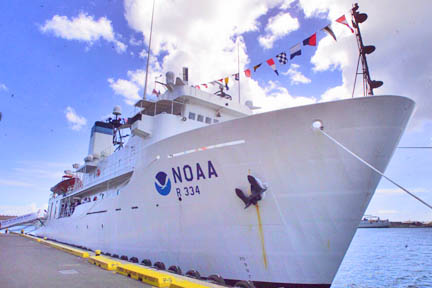

|
Ship will study reefs
in NW Hawaiian Isles
NOAA's new research vessel will sail
on its first voyage Sept. 13
The ship Hi'ialakai opens a new era for studying the coral reefs of the Northwestern Hawaiian Islands, said scientists at the ship's commissioning yesterday at Aloha Tower.
The 224-foot National Oceanic and Atmospheric Administration vessel sails on its first research voyage to the Northwestern Hawaiian Islands on Sept. 13.
Built from scratch, such a ship could cost $50 million, estimated Dan Basta, director of NOAA's National Marine Sanctuary Program.
Instead, the 20-year-old ex-Navy T-AGOS Class vessel has had a $6 million makeover that added facilities for scuba diving, including a recompression chamber, laboratories and computer systems, and five small boats aboard to shuttle research teams to work locations.
To be added this fall, after the maiden voyage: equipment that uses sound to create highly detailed maps of the sea floor.
"It's very tricked out," said Randall Kosaki, research coordinator for the Northwestern Hawaiian Islands Coral Reef Ecosystem Reserve.
Kosaki will coordinate the work of 18 scientists on a 35-day voyage. The federal, state and university scientists will be studying coral, fish, invertebrate animals, algae and the ocean itself. Also on board will be 24 ship crew, a science writer and two photographers.
The sheer distance of the northwestern islands from the main Hawaiian islands has limited in-depth study of them before now. With the capacity to stay at sea three months, "this ship allows us to get out there often enough to keep a finger on the pulse of the ecosystem," Kosaki said.
About 70 percent of the coral reefs found in the United States are in the Northwestern Hawaiian Islands. Its atolls and islands are home to the endangered Hawaiian monk seal and are key nesting sites for threatened green sea turtles and dozens of species of sea birds.
The Hi'ialakai "will help us better understand and manage the waters of the Pacific," U.S. Sen. Daniel Inouye said.
The ship's Hawaiian name, which can translate as either "embracing pathways to the sea" or "the leader of the sea," was bestowed by Isabella Abbott, a University of Hawaii professor emeritus known for her pioneering studies of Northwest Hawaiian Island seaweed.
"She said if we were good, she'd name an algae after us," the ship's commander, Scott Kuester said.
The new ship joins two other NOAA research vessels based in Hawaii which focus on fisheries research and oceanography. During the winter, when the weather makes work in the northwestern islands difficult, the Hi'ialakai will do mapping and ecosystem study in the main Hawaiian islands.
The Northwestern Hawaiian Islands Coral Reef Ecosystem Reserve was established by then-President Bill Clinton in 2000 and is in the process of becoming a National Marine Sanctuary. Portions of the unique area are managed by the U.S. Fish and Wildlife Service and state Department of Land and Natural Resources.